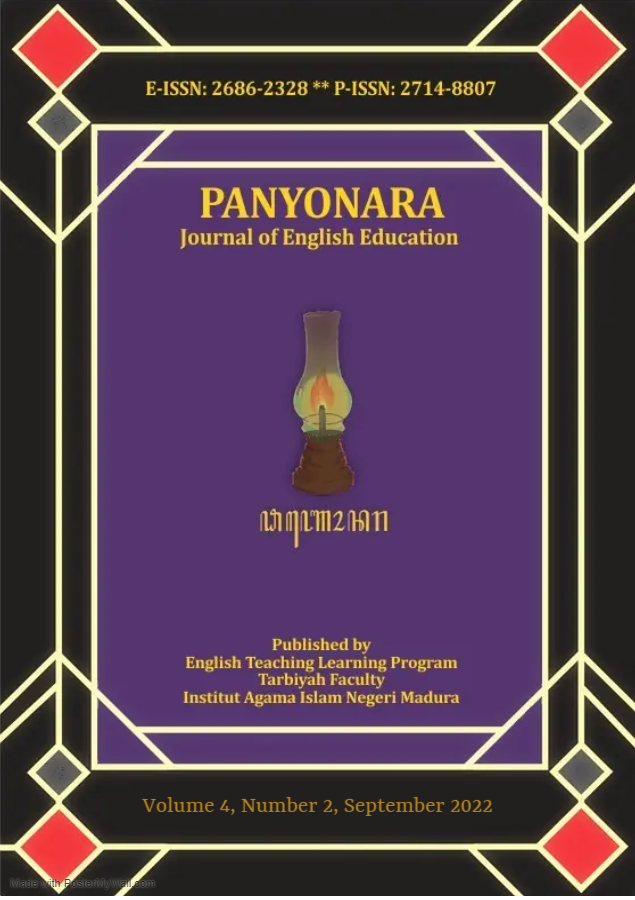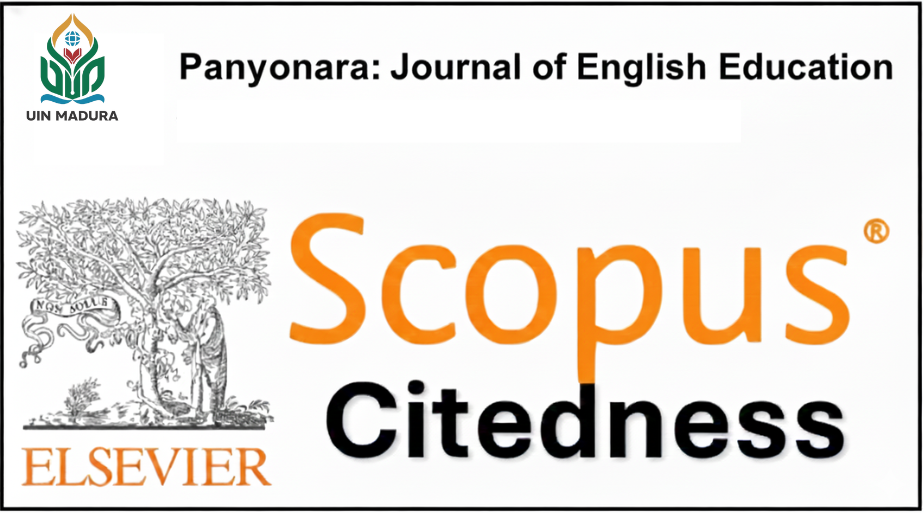Interlanguage Analysis of Indonesian Young Learner’s English Acquisition
 Abstract views: 736
,
Abstract views: 736
,
 PDF downloads: 478
PDF downloads: 478
Abstract
The current trend of ELT in Indonesia is to learn English at young age. Young learners are perceived as more successful language learners compared to those learning English in their adulthood. This article aims at analyzing interlanguage variations of Indonesian young learners, serving as evidence of their English acquisition. The findings showed that Indonesian young learners of English have not been able to produce tense-marking verb, and omit some grammatical morphemes such as –s iending in simple present tense, and –s ending in possessive. The interlanguage variations are influenced by L1 transfer, overgeneralization and simplification. It is expected that the findings contribute to better comprehension of Indonesian learners’ English acquisition..
Downloads
References
Adams, M. J. (1990). Beginning to Read: Thinking and Learning about Print. MIT Press.
AI-Ansari, S. (2001). Two types of language exposure as predictors of students’ academic success in EFL: A case study of undergraduate students at the university of Bahrain. Journal of King Saud University Languages & Translation, 13, 91–108.
Al-Hazmi, & Schofield, P. (2007). EFL writing: The example of Saudi university students. 8(2), 237–267.
Ammon, U. (2011). The European Union (EU – formerly European Community): Status change of English during the last fifty years. In The European Union (EU – formerly European Community): Status change of English during the last fifty years (pp. 241–268). De Gruyter Mouton. https://doi.org/10.1515/9783110872187.241
Babawarun, T. (2006). Interlanguage. In An Encyclopedia of the Arts (pp. 39–42).
Bataineh, R. (2005). Jordanian undergraduate EFL students’ errors in the use of the indefinite. The Asian EFL Journal Quarterly, 7(1), 56–76.
Bialystok, E. (n.d.). Acquisition of Literacy in Bilingual Children: A Framework for Research. In Language Learning (pp. 159–199).
Bialystok, E., & Hakuta, K. (1995). In Other Words: The Science And Psychology Of Second-language Acquisition. Basic Books.
Brown, H. D., & Wen, Q. (文秋芳)•. (1994). Teaching by principles: An interactive approach to language pedagogy (Vol. 1). Prentice Hall Regents New Jersey.
Burt, M. K., Dulay, H. C., & Krashen, S. D. (1982). Language two. Oxford University Press.
Cahyono, B. Y. (n.d.). Aida and Her Mainstream Classroom: A Case Linguistic variation of Language Learner’s Literacy Development. 14(2).
Chen, Y. (2002). The problems of university EFL writing in Taiwan. 5(1), 59–79.
Cheng, C., Wang, M., & Perfetti, C. A. (2011). Acquisition of compound words in Chinese–English bilingual children: Decomposition and cross-language activation. Applied Psycholinguistics, 32(3), 583–600. https://doi.org/10.1017/S0142716411000221
Cook, V. (2013). Second language learning and language teaching. Routledge. http://books.google.com/books?hl=en&lr=&id=Ma0uAgAAQBAJ&oi=fnd&pg=PP1&dq=language+teaching+journal&ots=uXespOEXif&sig=7Hm39uJ5bOmWCnqkaLCSYHcKLaA
Cummins, J. (1976). The Influence of Bilingualism on Cognitive Growth: A Synthesis of Research Findings and Explanatory Hypotheses. In Working Papers on Bilingualism (pp. 1–43).
Dulay, H. C., Burt, M. K., Krashen, S. D., & Krashen, S. (1982). Language Two. Oxford University Press.
Ellis, R. (1986). Understanding Second Language Acquisition.
Ellis, R. (1989). Understanding second language acquisition (Vol. 31). Oxford university press Oxford.
Ellis, R. (1994). Understanding Second Language Acquisition. Oxford University Press.
Ellis, R. (1997). Second Language Acquisition (Oxford Introduction to Language Study)—Google Books.
Espada-Gustilo, L. (2009). Sentence-level errors in ESL writers’ diagnostic essays: What students have achieved and what we can do. Philippine ESL Journal, 3, 108–126.
Fillmore, L. W. (1991). When Learning a Second Language Means Losing the First. Undefined. https://www.semanticscholar.org/author/Lily-Wong-Fillmore/67094846
Ghofur, A. (2017). CREATIVE TEACHING. OKARA: Jurnal Bahasa Dan Sastra, 6(2).
Gitasaki, C. (2006). Second Language Acquisition Theories: Overview and Evaluation. https://espace.library.uq.edu.au/view/UQ:9550
Guo, L. Y. (2009). Acquisition of auxiliary and copula be in young English-speaking children—ProQuest. https://www.proquest.com/openview/393437d8733682527e03ad57dba13dd7/1?pq-origsite=gscholar&cbl=18750
Ibrahim, R. (2006). Do languages with cognate relationships have advantages in second language acquisition. The Linguistics Journal, 1, 66–96.
James, C. (1998). Interlanguage variations in Language Learning and Use: Exploring Error Analysis. Essex: Addison Wesley Longman, Ltd.
Krashen, S. D. (1982). Principles and practice in second language acquisition (1st ed). Pergamon.
Larsen-Freeman, D., & Long, M. H. (1991). An Introduction to Second Language Acquisition Research. Longman New York.
Lessard-Clouston, M. (2017). Second Language Acquisition Applied to English Language Teaching. TESOL International Association.
Lightbown, P. M., & Spada, N. (2006). How Languages are Learned: An Introduction to the Main Theories of First and Second Language Acquisition (now in a New, Updated Edition). OUP Oxford.
Long, M. H. (1991). Focus on form: A design feature in language teaching methodology. Foreign Language Research in Cross-Cultural Perspective, 2, 39–52.
Lucas, R. (2008). Biological Bases of Language Learning.
Luna, R. M. (2010). Interlanguage in undergraduates’ academic English.
Master, P. (1988). Acquiring the English Article System: A Cross-Linguistic Interlanguage Analysis. https://eric.ed.gov/?id=ED298768
McLaughlin, B. (1984). Second Language Acquisition in Childhood: Vol. 1 Preschool children (2nd ed.). NJ: Erlbaum.
Nayan, S., & Jusoff, K. (2009). A Study of Subject-Verb Agreement: From Novice Writers to Expert Writers. International Education Studies, 2(3), p190. https://doi.org/10.5539/ies.v2n3p190
Octaberlina, L. R. (2013). Interlanguage Variations of Indonesian EFL Learners. [Dissertation]. State University of Malang.
Paradis, J. (2010). Bilingual Children’s Acquisition of English Verb Morphology: Effects of Language Exposure, Structure Complexity, and Task Type. Language Learning, 60(3), 651–680. https://doi.org/10.1111/j.1467-9922.2010.00567.x
Paradis, J. (2011). Individual differences in child English second language acquisition: Comparing child-internal and child-external factors. Linguistic Approaches to Bilingualism, 1, 213–237. https://doi.org/10.1075/lab.1.3.01par
Richards, J. C., & Renandya, W. A. (2002). Methodology in Language Teaching: An Anthology of Current Practice. Cambridge University Press.
Saville, T., M. (2006). Saville-Troike, M. 2006. Introducing Second Language Acquisition. New York: Cambridge University Press. Cambridge University Press.
Silburn, S. R. (Ed.). (2011). Early years English language acquisition and instructional approaches for Aboriginal students with home languages other than English: A systematic review of the Australian and international literature. Menzies School of Health Research.
Taeschner, T. (1986). Second Language Acquisition in Childhood: Volume 1. Preschool Children. Barry Mclaughlin. Second Edition. Hillsdale, N.J.: Lawrence Erlbaum, 1984. Pp. xiv + 261. Applied Psycholinguistics, 7(2), 175–178. https://doi.org/10.1017/S0142716400007414
The Effects of Vocabulary Instruction: A Model-Based Meta-Analysis—Steven A. Stahl, Marilyn M. Fairbanks, 1986. (n.d.). Retrieved September 7, 2022, from https://journals.sagepub.com/doi/10.3102/00346543056001072
Yuningsih. (2007). Yuningsih.2007. Analyzing the Usage of Simple Past Tense and Present Perfect Tense of Third Semester Students of English Department: A Case Study of Second Year Students’ Composition. Poltekkom.Bandung.English. http.www://poltekkom.bandung.english.analyzing.the.usage.of.past.tense.and.perfect.tense.com
The journal uses an Open Access policy under a Creative Commons Attribution-NonCommercial 4.0 International License. Authors who publish with this journal agree to the following terms:
- Authors retain copyright and grant the journal right of first publication with the work simultaneously licensed under a Creative Commons Attribution License that allows others to share the work with an acknowledgment of the work's authorship and initial publication in this journal.
- Authors are able to enter into separate, additional contractual arrangements for the non-exclusive distribution of the journal's published version of the work (e.g., post it to an institutional repository or publish it in a book), with an acknowledgment of its initial publication in this journal.
- Authors are permitted and encouraged to post their work online (e.g., in institutional repositories or on their website) prior to and during the submission process, as it can lead to productive exchanges, as well as earlier and greater citation of published work.

















